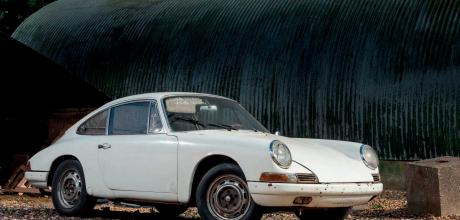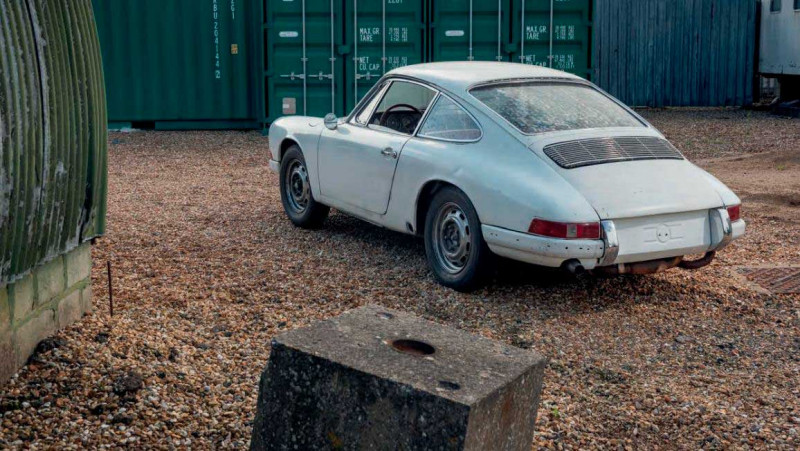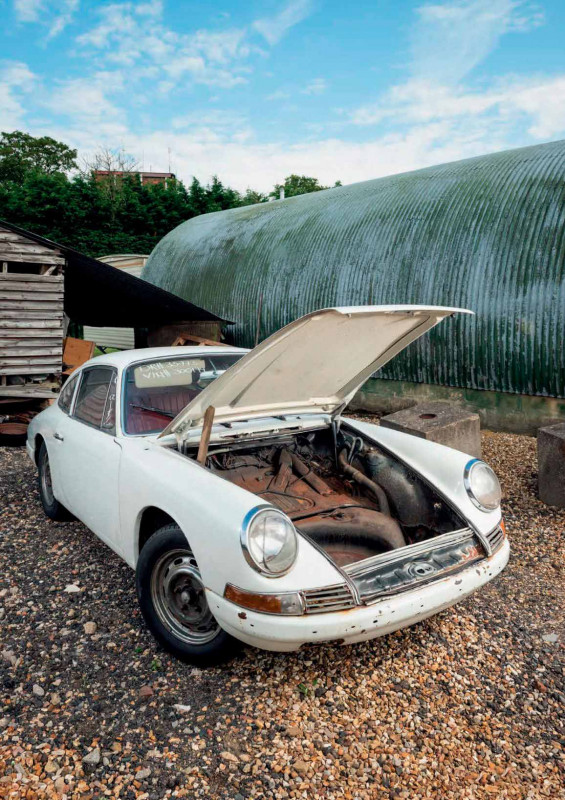Magnus Walker’s 1964 Porsche 901 project

A tired 911 is a great starting point for your journey into Porsche personalisation, but what if you happen upon one of the earliest, rarest and most valuable Stuttgart-crested six-cylinder production cars out there? This was the exact dilemma faced by Urban Outlaw, Magnus Walker, when he became the owner of a 901… Words Dan Furr Photography Dan Sherwood.
DRAW THE LINE
Home restorers and driveway-dwelling mechanics have been modifying Porsches for as long as the manufacturer has been producing cars, but the past decade has seen the rise of a new kind of restomod, where the principles of hobby-driven enthusiasm for Porsche personalisation and those of professional restorations by respected marque specialists combine to produce a unique Stuttgart speed machine. Of course, big-budget builds are nothing new, especially when it comes to pure Porsche restoration, but many of today’s air-cooled restomods take grassroots modifying and propel the approach to astronomical new heights through the use of exotic materials, unique styling and, as is the case with brands such as Singer and Gunther Werks, an enthusiastic disregard for cost.

What exactly is a restomod? Essentially, it’s the practice of taking a tired old car and giving it a new lease of life through the appointment of modern driving equipment. We’re talking increased performance, enhanced styling, superior reliability. Again, there’s nothing new in any of this, but it’s the approach and acceptance of this behaviour that’s changed. No longer is your mate’s dad seen to be ‘ruining’ his vintage 911 by fitting non-standard parts from the comfort of his own garage — where he was once getting oil under his fingernails, he’s now more likely to be detaching his car from its original specification by instructing specialists to develop the vehicle into the epitome of automotive sophistication at great expense. And he’ll be applauded for doing so. What was once detrimental is now desirable. What used to be frowned upon is now celebrated. Observing originality? Pah!
WORK FOR LOVE

Okay, the game’s up — we accept Porsche preservation is vitally important, not only in terms of a car’s historical significance, but also in the interests of maintaining its financial worth, but if an old Porsche is already in tired cosmetic or mechanical condition, or is missing components otherwise contributing to maintaining factory specification, then these cars can be seen as something of a ‘blank canvas’, affording owners the opportunity to personalise to their heart’s content. And as far as Porsche enthusiasts are concerned, one man is doing so with a higher public profile than any other: Magnus Walker.
Along with Singer, the self-styled Urban Outlaw must be given credit for ‘normalising’ the way in which Porsche restomods are viewed today. In downtown Los Angeles, he curates an impressive portfolio of personalised Porsches — primarily air-cooled cars, but also modern classics from the brand’s transaxle family of products — with the core of the collection centred around owning one of every generation of 911. Each car is modified, resulting in a distinct look inspiring loyal followers, so much so that many leading automotive brands, including styling and accessories giant, MOMO, and wheel manufacturer, Fifteen52, aware of the buzz across social media generated by Walker’s projects, have worked with him to create signature lines of their offerings. As his audience grew (his Instagram account currently boasts almost 800k followers), it was inevitable Porsche would sit up and take notice, and when it did, not least by way of outlining his life story in the brand’s own long-running magazine, Christophorus, many saw it as endorsement of the wider restomod scene. Even Walker knows where to draw the line, though. Allow us to explain.
If you want to own one of every generation 911, your collection will need to include the Holy Grail: an early 911. A really early 911, in fact, before the 911 was known as the 911. On 12th September 1963, at the Frankfurt Motor Show, Porsche unveiled the 356’s successor, the newly developed 901, fresh from the pen of Ferdinand ‘Butzi’ Porsche. There was, however, trouble in paradise. French carmaker, Peugeot, objected to the Stuttgart squad using any three-digit model name featuring a zero in the middle, asserting ownership of naming rights. Subsequently, Ferry Porsche gave the order for the 901 identifier to be changed. Its zero was swiftly replaced with a 1 in readiness for the new car’s market launch in 1964. One benefit of this pragmatic solution was how it prevented extensive changes being made to print layouts already prepared for sales and advertising copy, operating manuals and other documentation. The 911 was born.
901s are known to feature many unique pre-mass production components — such as a totally flat slam panel free of pressings — when compared 911s built for the 1965 and 1966 model years. We’re delighted to confirm one of these very rare, super-early cars is what you see on the pages before you. Manufactured on 8th December 1964 and carrying chassis number 300174 (and gearbox 063-901), the left-hand drive rarity is considered one the most original unrestored 901s in existence, retaining virtually all its unique parts.
No wonder Walker was excited to learn of the car’s availability when he was told of its whereabouts almost a decade ago.
Supplied new to its first owner, Mr Herbert Ritter, by Munich-based Porsche dealer, MAHAG, on 8th January 1965, the car was originally presented in one of the most desirable Porsche colour combinations, namely Slate Grey bodywork over red leatherette with houndstooth inserts. Two years later, 300174 was purchased by a US serviceman based in Germany and, in 1970, when he returned to his home country, the little Porsche was shipped Stateside, whereupon it was promptly bought by its third owner, a sports car fan based in Pennsylvania. During the following seven years, the car was used regularly, but by 1978, 300174 was tired and in need of recommissioning work. Indicating a sign of the times and in keeping with all other 901s produced before the 911 name was introduced, thirteen years after construction, this early chassis wasn’t considered historically significant, and it was this nonplus attitude which saw 300174 retired from the road and kept in dry storage until 2012.
Between September 14th 1963 and the close of 1964, eighty-two examples of the 901 were built, a fact highlighting how even the wealthiest, most determined Porschephile will have a tough time locating a surviving example in the present. Needless to say, when Walker was notified of 300174’s existence after two years searching for a 901 to call his own, he hopped onto a plane from California to Pennsylvania and, eight hours later, was arranging for the dormant Porsche to be shipped to Los Angeles. There was only one problem: when the car eventually landed at Chez Walker, its new owner had no idea what he was going to do with his new toy. After all, here was one of the world’s most famous restomodders in possession of one of the world’s rarest sports cars. The assumption was he’d take it apart and put it back together again in his own inimitable fashion, but he couldn’t bring himself to do it. Such history, such prestige. This weary air-cooled Porsche needed to be fully restored to factory specification under the watchful eye of an owner who would enjoy resurrecting originality without compromise. Admirably, Walker accepted he was, quite simply, the wrong man for the job.
This isn’t to say he parted with the car straightaway, mind. In a shrewd move, recognising increasing interest and a rapid rise in the value of 901s, he held onto chassis 300174 until it was time to make space for new projects. Enter Mick Pacey, head of classic Porsche restoration and sales specialist, Export 56, based in Bedfordshire, England, and boasting more than thirty years of experience in the acquisition, restoration and preservation of classic Porsches. “This particular car is utterly extraordinary,” he tells us. “Many Porsches of this era were stripped or turned into race cars, losing a huge amount of their rare standard equipment. This car not only retains ninety-five percent of what it was kitted-out with when it left the factory, it has never been restored, meaning later 911 body panels and other components not true to the 901 design haven’t found their way into the mix. It really is a remarkable Porsche and, with a client keen to add a 901 to his collection, I didn’t hesitate in contacting Magnus Walker with a request to bring 300174 to the United Kingdom.”
Forty years of inactivity and dry storage had preserved the car, but Mick is keen to stress the 901 he was presented with was by no means “the romantic ideal of fitting fresh tyres, putting new oil in the engine and driving off.” It’s a big project. “I estimate 2,500 hours are needed to sort this Porsche,” he reveals. “You can’t resurrect a 901 the same way you would approach, say, a 1967 911 S restoration. Every single component on this car needs to be removed, documented, stripped, refurbished and reinstalled. Finding any required 901 parts will be a massive challenge, but everything about this Porsche needs to be restored absolutely period correct. Thankfully, this car offers a head start for a full, sympathetic and accurate restoration back to factory specification due to it being kept complete by successive owners, including Magnus, but nobody should underestimate what’s involved in a project like this. It’s a mammoth task.” The flat-six (engine number 900243), though not operational since 1978, has never been apart and retains its original Solex carburettors, air cleaners and all other items fitted in period, which may come as a surprise when you look at the body, which definitely isn’t finished in Slate Grey.
“At some point in its life, the car was treated to a rough paint job.” Mick says. “The original colour remains visible on patches of the door shuts, slam panel and other areas, but the entire body needs stripping to a shell. As you’d expect of any unrestored 901 or 911, there’s rot in the usual places, but this won’t be a regular restoration. The attention to detail and care required when dismantling, restoring and reassembling this car will be beyond the scope of what most Porsche restorers have dealt with.” Fortunately, another special 901, arguably the world’s best presented example and a car formerly owned by none other than Alois Ruf Jr, is also in the custody of Export 56, thereby providing an invaluable source of reference. Ruf himself, a man many see as one of the elder statesmen of the Porsche restomodding scene (along with the late Uwe Gemballa), has restored half a dozen of the surviving 901s and has huge knowledge of the intricacies and peculiarities of the model over the production 911s which followed, but make no mistake, if these authorities on air-cooled Porsches recognise even a complete 901 presents a project not for the feint hearted, then anyone taking on responsibility for the build needs deep pockets and a huge amount of patience. “Budget for the worst and hope for the best,” laughs Mick.
But wait! Hasn’t Export 56 already got a client lined up for 300174? “We did,” Mick continues, “but due to a life-altering set of circumstances, he’s had to change his plans. Consequently, the car is now available for anyone interested in owning a serious piece of Porsche history and one of the earliest, rarest six-cylinder production Porsches in existence. It really does present a fantastic opportunity for the right buyer, and Magnus has confirmed his willingness to remain involved, certainly as far as promoting the project to a wider audience is concerned.” A super-rare Porsche ready and available for restoration, complete with unrivalled provenance and ongoing endorsement from a factory-approved Porsche personality who also happens to be one of the car’s quartet of past owners? The world’s leading concours car events await.
Above Not even the Porsche Museum is on possession of a ‘matching numbers’ 901. Above Engine hasn’t been operational since the car’s retirement in Pennsylvania in the late 1970s Below Note the perfectly flat slam pane free of pressings. Above Chassis plate for 300174, built in late 1964 and supplied new in January 1965. Facing page Splashes of the original Slate Grey paintwork can be see in the door shuts. Left Magnus Walker wasn’t sure what to do with the car, but knew a restomod was the wrong course of action.

